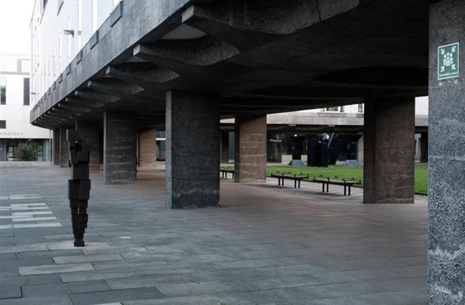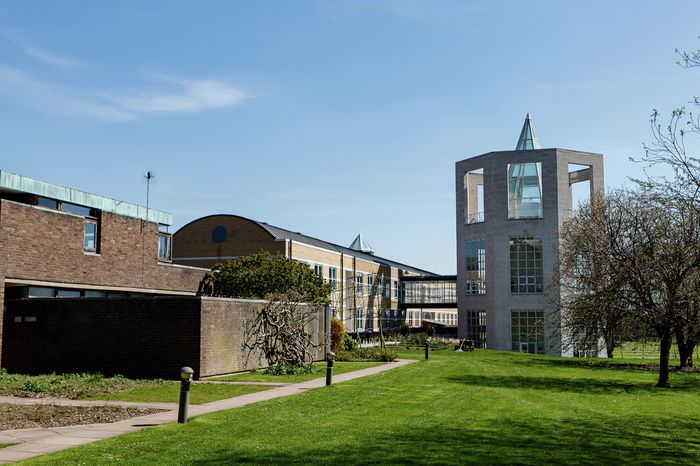In defence of the Sidgwick sights
Anna Wythe delves into the architectural history of the Sidgwick site, arguing in defence of its brutalist beauty and concrete quirkiness

One of the very few things I miss about being a teenager is drinking in the park after dark. It’s not the cheap wine or the inevitable disappointment; it’s the strange shadowy silhouettes of a playground suddenly decontextualised. When no one thinks to play on them, the climbing frames and seesaws become as quasi-artistic and lonely as the teenagers drinking in their shadows.
A walk through Sidgwick Site late in the evening recently reminded me of that atmosphere. Stripped of schedules and Cambridge glitterati, it becomes mere shapes and lines. Especially in the rain, it’s a wonderful place: not comforting but beautiful in a cold geometrical way.
I realise I’m wading against the tide of public opinion when I describe Sidgwick as beautiful. So often the physical space is decried as ugly, industrial and hellish, but I won’t contradict anyone’s “vibe”’. The beauty of it is for me at 3am, not public discourse.
I do think, though, that the architecture of Sidgwick is more interesting and more fit-for-purpose than it is sometimes given credit for. The only caveat for this claim is that everything I know about architecture comes from Wikipedia and BBC documentaries.
“It’s Fritz Lang meets Joy division. It’s cool”
My true love on Sidgwick is the raised MMLL faculty building. It is, for want of better words, wacky as hell. Part of the original 1950s Sidgwick, the raised faculty building is the work of the Casson Conder company, masterminds of the northern half of the site, including the Economics Faculty and Lady Margaret Hall. Casson Conder brought a distinctly brutalist approach to these early constructions. The reinforced concrete pilotis are straight out of the Le Corbusier playbook, which is to say, they refer back to the early purist vision for brutalism. The strange corridor spaces beneath the building have the sense of a tunnel even in daylight. It’s Fritz Lang meets Joy division. It’s cool.
I find it curious that people manage to describe brutalist architecture as both “inhuman” and “unnatural”. Perhaps the UFO conspiracies about ancient monuments have made their way into the 20th century. There certainly seems to be a sense that giant man-made structures are somehow uncanny and disturbing. But what causes this discomfort?
At the heart of brutalism, there is the idea of truth. It aims to take away the decoration, the ornament. It shows honestly the materials used in construction (famously, reinforced concrete) and the mechanisms of design (like the pilotis). It isn’t necessarily, however, the faceless architecture of anonymous apartment buildings. As Jonathan Meades informed me via YouTube, truly brutalist buildings are made by pouring concrete moulds on-site, a technique which gives architects more freedom to create new and different shapes. It is an architecture unique through its nakedness, not its clothes: architecture sans skinny scarf, sans trench coat.
“You look at the concrete and it looks right back at you”
Although the raised faculty building is a restrained example of brutalism, it still holds that suggestion of nakedness. It is the opposite of domestic space. The scale precludes intimacy. The exposed design precludes privacy. Perhaps this is what disturbs us. Perhaps it is the lack of escapism in this kind of architecture. You look at the concrete and it looks right back at you. So too, there is none of the overwhelming harmony you might find in the King’s College Chapel ceiling or the Wren Library. Brutalism doesn’t promise a coherent ordering of the universe. If there’s a spiritualism to it, it comes from what a human mind will do staring at a blank wall.
Personally, I wouldn’t object if the whole of Sidgwick site was poured from a single concrete mould. Nevertheless, the south side breaks open into something very different. The buildings are more postmodern, or at least more open to reference and representation. They include the spiral staircase to heaven (the divinity faculty), the corporate cathedral (the law faculty), and most famously, the history faculty designed by James Stirling.
In breaking with the austerity of brutalism, Stirling also broke with its functionality. Leaks and temperature problems have plagued the history faculty building since the 60s. Indeed, I can testify that it remains to this day unable to keep its occupants warm in the winter. As Wikipedia so aptly observes: “Although the building was admired by students of architecture, it is less well regarded by those who have to work in it.”
Whatever the joys of critiquing Sidgwick’s south side, it reveals a fascinating fragmentation of design in a very compact space. If modern architecture is often criticised for monotony, the buildings on Sidgwick retain particularity. I like the mishmash that results. Academia is no longer one nation under God, and there’s no point in giving it an artificial harmony through architecture. Sidgwick is perhaps a harsh visual environment, but it’s not an inhuman one. It makes us uncomfortable in all the right ways and it’s beautiful at 3am.
 News / Cambridge postgrad re-elected as City councillor4 May 2024
News / Cambridge postgrad re-elected as City councillor4 May 2024 News / Gender attainment gap to be excluded from Cambridge access report3 May 2024
News / Gender attainment gap to be excluded from Cambridge access report3 May 2024 Comment / Accepting black people into Cambridge is not an act of discrimination3 May 2024
Comment / Accepting black people into Cambridge is not an act of discrimination3 May 2024 News / Academics call for Cambridge to drop investigation into ‘race realist’ fellow2 May 2024
News / Academics call for Cambridge to drop investigation into ‘race realist’ fellow2 May 2024 News / Some supervisors’ effective pay rate £3 below living wage, new report finds5 May 2024
News / Some supervisors’ effective pay rate £3 below living wage, new report finds5 May 2024




